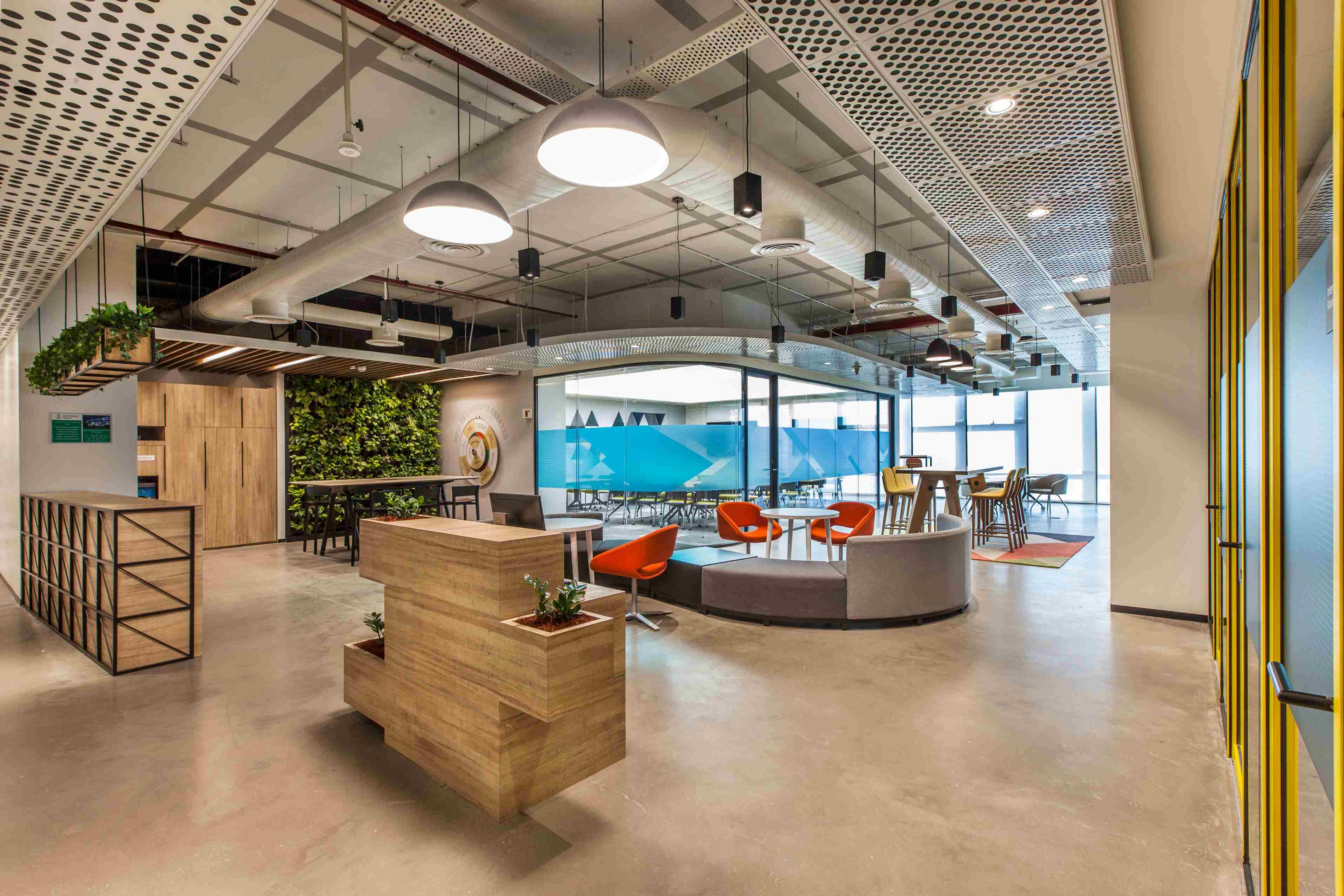Biophilic office design in the post COVID-19 workplace
For many employees, coming into the post-pandemic office can be an anxiety-inducing exercise. Health-related concerns, coupled with the uncertainties of navigating a recalibrated workplace and worries about domestic and childcare responsibilities, is bound to leave them emotionally wrung out. That’s why workplace experts are increasingly seeing biophilic office design as an important element in the post-COVID workplace.
Being surrounded by biophilic elements has proven physiological and psychological advantages. And, besides improving indoor air quality, greenery can make the workplace soothing and welcoming. After the last few stressful months, this might be just what people need as they transition back to the office.
What is biophilic design?
The sound of ocean waves, the serene view of leaves dancing in the wind, the refreshing feeling of dipping your feet into a pool – these are just a few experiences that have universal appeal. This inherent connection that human beings have with nature and green spaces is called biophilia.
The importance of biophilic design in post-pandemic workspaces
Especially now, when concerns about air quality and wellbeing are equally important, biophilic office design conceptualises spaces that leverage the rejuvenative properties of nature. It weaves natural elements into everyday spaces, triggering positive biological and psychological responses.
In the post-pandemic workplace, it might not be possible to have the same level of social contact between employees as there was before, leading to reduced feelings of connectedness and increased loneliness and anxiety. Being surrounded by biophilic elements, however, can reduce stress, lower blood pressure and steady the heart rate. This has tangible results on an employee’s performance and day-to-day functioning. People enjoy improved concentration, attentiveness and cognitive functions, thereby being more productive and offering a better creative output. Employees are able to derive a higher level of satisfaction from their job and feel more connected to the workplace, which in the long run, helps companies keep their workforce healthy, happy and motivated. This results in improved talent retention and lower rates of absenteeism, too.
Here are seven ways to include biophilic elements in workplaces.
1. Visual elements
CSG International, Bangalore
Visual elements of nature help reduce stress and fatigue. In fact, mere exposure to the colour green has a positive impact on creative performance. This is certainly not hard to imagine – just think of working in a bland cubicle, as opposed to working in an earthy space resplendent with flowers and potted plants.
An extremely popular modern office design trend, green walls are a great way to embrace biophilia. We recently helped
CSG International install a luxurious moss wall in their new workspace in Bangalore. Located at the reception area, it imparts a cool, welcoming atmosphere that stays with you even as you go deeper into the office.
While green walls require a bit of planning and maintenance, there are simpler ways of introducing visual biophilic elements. If you’re planning to add partitions to each desk, for instance, consider using ferns and potted plants to partially cover them and make the space feel less clinical and more welcoming. Terrariums on individual desks, and koi pond installations in the common areas are also great ways to bring a bit of nature indoors. Even artwork depicting natural landscapes have a more relaxing effect than abstract prints or city scenes.
2. Auditory elements
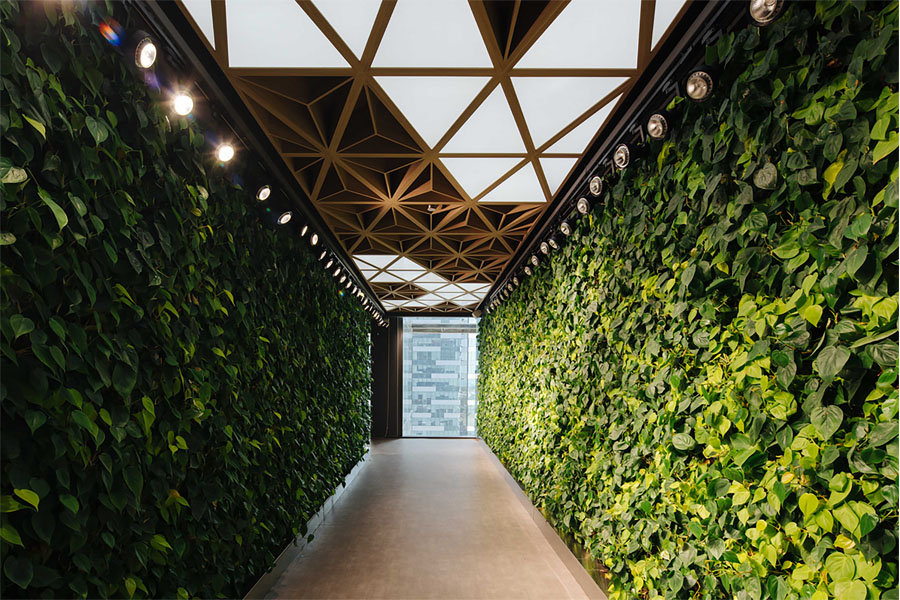 Prudential WorkPLAYce, Singapore
Prudential WorkPLAYce, Singapore
Anybody who has been to a spa would know the soothing soundtrack of waves and winds they have on in the background. Apart from contributing to the atmosphere of relaxation and wellness, natural sounds hasten the process of healing and psychological restoration by 37% as compared to city noises, or even silence.
1 As employees adapt to new ways of interacting in the New Normal workplace, they will find familiar sounds from nature especially comforting.
The
award-winning office design of Prudential’s WorkPLAYce incorporates natural auditory elements for a very soothing effect. The linkway on the first floor forms a corridor of thick foliage and is equipped with motion sensors that trigger the sound of chirping birds as one walks across. The passage on the second floor features cascading water installations on the walls, which simulates the soothing noise of a waterfall.
3. Olfactory elements
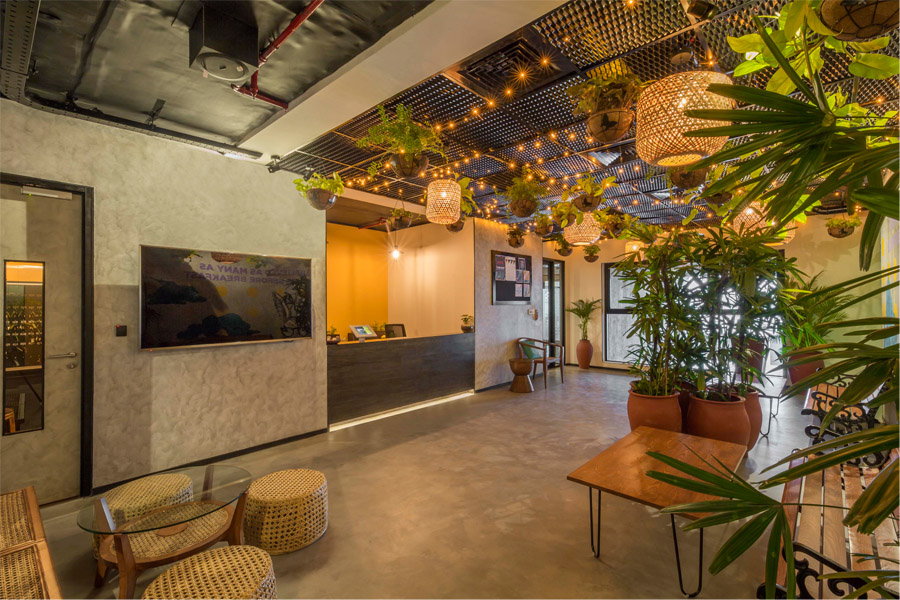 The Hive, Bangalore
The Hive, Bangalore
Being surrounded by nature subjects one to fragrances that are extremely healing and incredibly memorable. It takes no effort to remember the smell of soil in the rain, fresh cut grass or a bunch of roses. Given that scents trigger powerful memories in the human brain, using natural fragrances in the workplace can induce the feeling of being outdoors.
Fresh flowers, plant oils and fruit essences can easily be diffused throughout an office space to have energising or calming effects. Having natural ventilation and adequate breezeways is another great way to ensure that employees can enjoy the smell of rain. The Hive in Bangalore has a reception area where diffusers have been strategically placed to evoke an instant connect with the greenery that one sees as one walks in.
4. The sense of touch
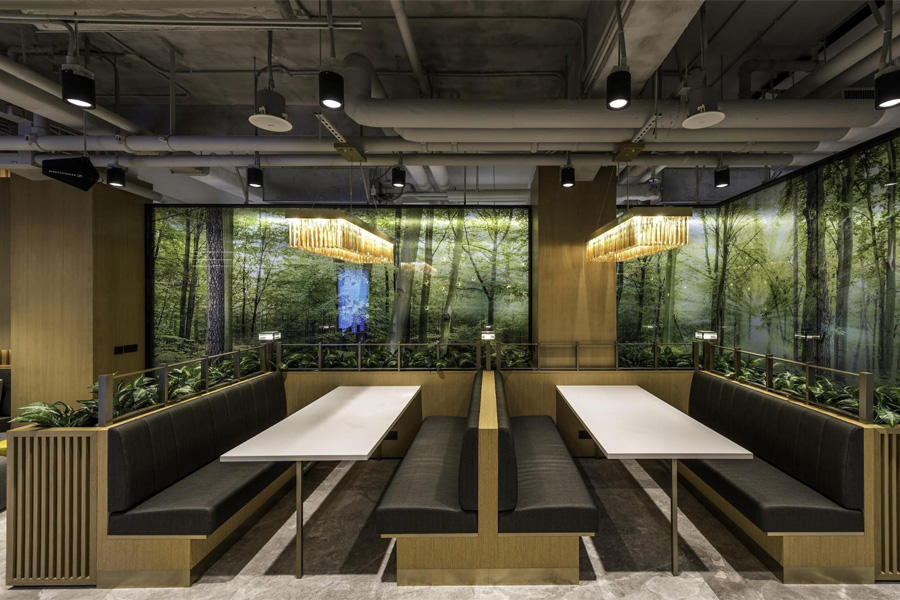 Li & Fung, Hong Kong
Li & Fung, Hong Kong
Our tactile senses play a big part in our experience of enjoying nature and being outdoors. Walking barefoot on the beach or running our fingers through our pets’ fur releases serotonin, oxytocin and other feel-good hormones that spark a lasting sense of delight. But of course, the post-pandemic workplace has to also take into account the need for no-touch fixtures and amenities to ensure maximum safety for all employees. In addition, common surfaces need to be treated with antimicrobial coatings or need to be easy to clean. These factors will impact how tactile design will be woven into the workplace.
Generally, including natural elements like wood, bamboo and stone, both in spaces where employees work as well as in break areas, would aid our tactile senses. Of course, it is important to get the ratio of these elements right. A room with a wood ratio of 45% induces a sense of comfort and well-being. But a wood ratio of 90% slows down brain activity – which might work well in spas and homes but is not a great idea for offices.
2 When considering materiality in today’s workplace, firms might want to include copper and copper alloys in high traffic areas. Not only does the virucidal properties of the material slow down transmission of disease, it also lends itself to various hues and textures.
And bringing together various textures is key here. Surfaces in nature are seldom smooth – the undulations, striations, roughness and softness give natural materials their unique characters. The Li & Fung office in Hong Kong is a good example of this. The slatted wood planters and the grained wood walls, together with the faux leather seats and the light fixtures, bring warmth and wellbeing into the space.
5. Thermal variability
Adobe, Bangalore
With the sun, clouds, and dynamic wind and air pressure, time spent outdoors is marked by constantly changing temperatures. Compare this to the constant blast of air conditioners in offices, which are often kept at a single setting round the year, making people feel cut off from the outside world.
In the post-pandemic workplace, HVAC systems have to mimic biophilia. Aside from getting intuitive HVAC units that mimic the weather outside and regulate the temperature constantly, the post-pandemic workplace needs systems that introduce fresh outdoor air into the office more frequently than before. Operable windows and air vents over individual workstations are important to ensure air quality. In cities where the weather permits it, one can create beautiful open-air nooks for people to work and relax in. For the Adobe office in the cloudy city of Bangalore, we used the often under-utilised rooftop area to create a cosy work corner with wooden seats, greenery all around and bright lights.
6. Light variability
Coca-Cola, Singapore
Just like dynamic temperatures, natural light conditions are always at a flux because of cloud cover and the time of the day. Our natural circadian rhythm has strong ties with this changing light. Being consistently exposed to harsh artificial lighting interrupts this rhythm, causing fatigue, boredom and sleeplessness at night, exacerbating health and wellbeing concerns during this already uncertain time.
The
Coca-Cola office in Singapore demonstrates a great way around this. The pantry has wall-to-wall windows, enabling employees to eat and chat bathed in natural sunlight. This break area thus refreshes people in every possible way. Offering adequate sensory variation is possible in rooms around the core of a building too. Accent lighting, dimmer switches and ceiling panels are great ways to keep the lighting dynamic.
7. Presence of water
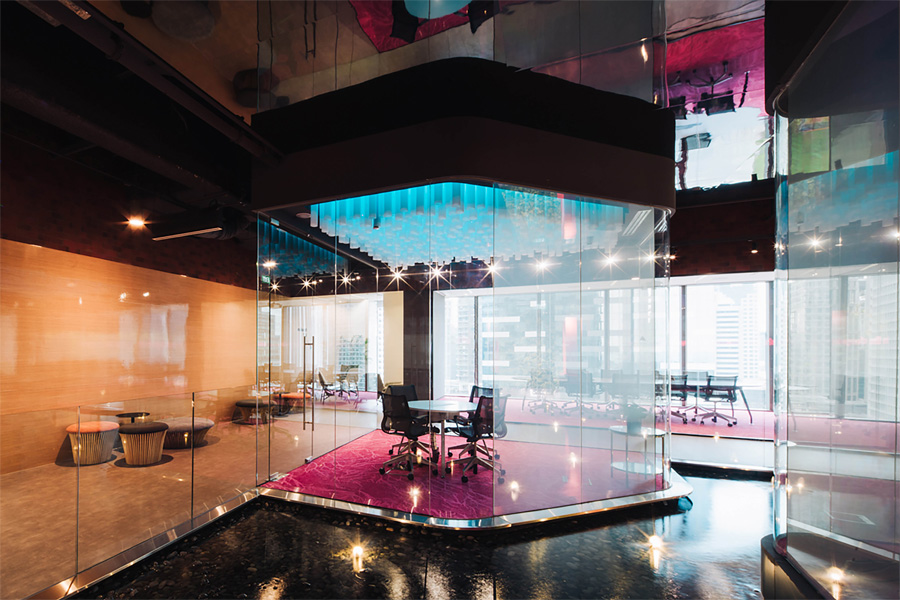 Prudential WorkPLAYce, Singapore
Prudential WorkPLAYce, Singapore
The presence of water adds fluidity in terms of sight, sound, touch and light patterns in a space. This has a soothing effect on people and has even been shown to enhance mood and boost self-esteem. Aquariums, fountains and even artwork depicting water bodies can create a sense of natural calm. For Prudential’s office, we conceptualised a sunken pool of water, on which glass-walled meeting rooms are built like small islands. Cool and subtly lit, it brings a sense of calm to meetings and brainstorming sessions.
In spacious offices, flowing water installations like fountains, water walls and constructed streams can stimulate the senses in situations like now, when many employees might be missing out on sensory stimuli. However, it is important to create a balanced installation, as extremely high volumes of water flow can be counter-intuitive and disturbing.
Excited to leverage the benefits of biophilic design in your post-pandemic workplace? We can help you bring nature indoors.

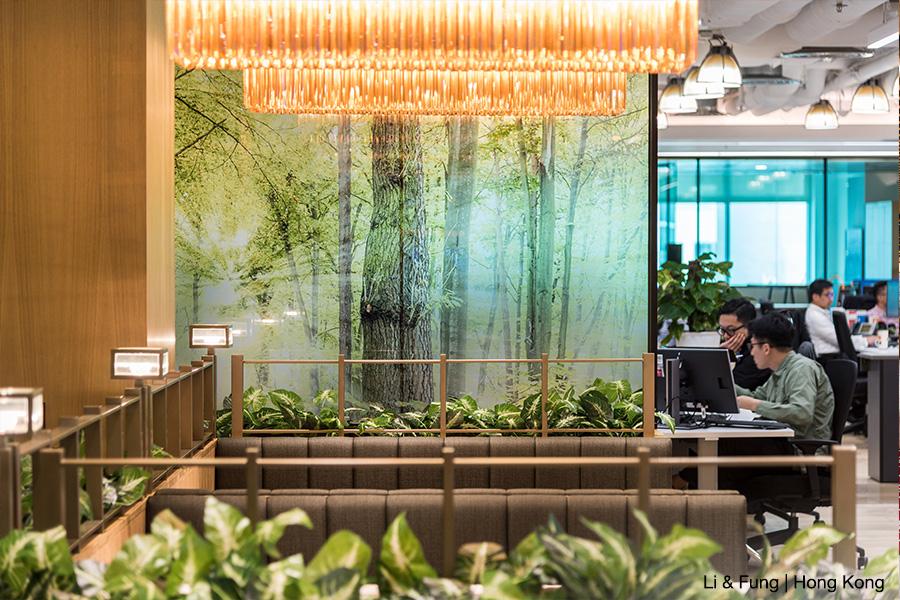
 Prudential WorkPLAYce, Singapore
Anybody who has been to a spa would know the soothing soundtrack of waves and winds they have on in the background. Apart from contributing to the atmosphere of relaxation and wellness, natural sounds hasten the process of healing and psychological restoration by 37% as compared to city noises, or even silence.
Prudential WorkPLAYce, Singapore
Anybody who has been to a spa would know the soothing soundtrack of waves and winds they have on in the background. Apart from contributing to the atmosphere of relaxation and wellness, natural sounds hasten the process of healing and psychological restoration by 37% as compared to city noises, or even silence. The Hive, Bangalore
Being surrounded by nature subjects one to fragrances that are extremely healing and incredibly memorable. It takes no effort to remember the smell of soil in the rain, fresh cut grass or a bunch of roses. Given that scents trigger powerful memories in the human brain, using natural fragrances in the workplace can induce the feeling of being outdoors.
Fresh flowers, plant oils and fruit essences can easily be diffused throughout an office space to have energising or calming effects. Having natural ventilation and adequate breezeways is another great way to ensure that employees can enjoy the smell of rain. The Hive in Bangalore has a reception area where diffusers have been strategically placed to evoke an instant connect with the greenery that one sees as one walks in.
The Hive, Bangalore
Being surrounded by nature subjects one to fragrances that are extremely healing and incredibly memorable. It takes no effort to remember the smell of soil in the rain, fresh cut grass or a bunch of roses. Given that scents trigger powerful memories in the human brain, using natural fragrances in the workplace can induce the feeling of being outdoors.
Fresh flowers, plant oils and fruit essences can easily be diffused throughout an office space to have energising or calming effects. Having natural ventilation and adequate breezeways is another great way to ensure that employees can enjoy the smell of rain. The Hive in Bangalore has a reception area where diffusers have been strategically placed to evoke an instant connect with the greenery that one sees as one walks in.
 Li & Fung, Hong Kong
Our tactile senses play a big part in our experience of enjoying nature and being outdoors. Walking barefoot on the beach or running our fingers through our pets’ fur releases serotonin, oxytocin and other feel-good hormones that spark a lasting sense of delight. But of course, the post-pandemic workplace has to also take into account the need for no-touch fixtures and amenities to ensure maximum safety for all employees. In addition, common surfaces need to be treated with antimicrobial coatings or need to be easy to clean. These factors will impact how tactile design will be woven into the workplace.
Generally, including natural elements like wood, bamboo and stone, both in spaces where employees work as well as in break areas, would aid our tactile senses. Of course, it is important to get the ratio of these elements right. A room with a wood ratio of 45% induces a sense of comfort and well-being. But a wood ratio of 90% slows down brain activity – which might work well in spas and homes but is not a great idea for offices.
Li & Fung, Hong Kong
Our tactile senses play a big part in our experience of enjoying nature and being outdoors. Walking barefoot on the beach or running our fingers through our pets’ fur releases serotonin, oxytocin and other feel-good hormones that spark a lasting sense of delight. But of course, the post-pandemic workplace has to also take into account the need for no-touch fixtures and amenities to ensure maximum safety for all employees. In addition, common surfaces need to be treated with antimicrobial coatings or need to be easy to clean. These factors will impact how tactile design will be woven into the workplace.
Generally, including natural elements like wood, bamboo and stone, both in spaces where employees work as well as in break areas, would aid our tactile senses. Of course, it is important to get the ratio of these elements right. A room with a wood ratio of 45% induces a sense of comfort and well-being. But a wood ratio of 90% slows down brain activity – which might work well in spas and homes but is not a great idea for offices. Prudential WorkPLAYce, Singapore
Prudential WorkPLAYce, Singapore

